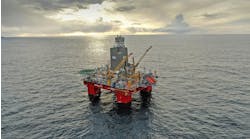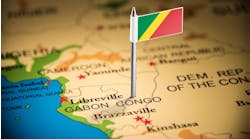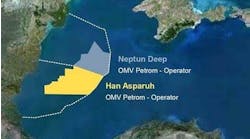Horizontal wells target thin layers of Troll's complex gas province
Nick Terdre
Contributing Editor
- Cross-section for Sognefjord formation showing pilot hole and well path of Troll oil production well 31/5-H-1AH.
- Typical well casing scheme and completion design for Norsk Hydro's horizontal wells into Trolls thin oil layers.
Troll oil is to be found in a number of different zones presenting challenges of differing complexity. In the Troll West Oil Province, the first area to be tackled, the zones are 22-27 metres thick, in the Troll West Gas Province, they are 12-14 metres thick, and in the Troll East Province, up to a mere four metres thick.
The oil layers are sandwiched between the gas reserves on top and a large underlying aquifer, according to Svein Erik Wennemo, the chief engineer for petroleum technology for the 1996 development plan. They must normally be produced first as production becomes increasingly difficult if pressure is reduced by taking gas from the reservoir. The reservoirs consist mainly of unconsolidated rock with high permeability, up to 20,000 MD.
So far the less thin layers of the Troll West Oil Province have been successfully developed, and Hydro is now awaiting approval for its plan to develop the Troll West Gas Province. With the start-up of gas production on Troll East last year, the ultra-thin layers in that part of the field will no longer be producible.
In 1988, when Hydro was considering how to tackle its immense task, the industry's experience with horizontal wells was limited to a small number of onshore wells with short horizontal sections. It was decided to drill two horizontal wells - one in the oil province and one in the gas province - and put them on long-term test.
The first well, in fact the first horizontal well on the Norwegian shelf, had a 500-metre horizontal section and was tested during 360 days. Its performance exceeded the high-case prediction, even though water breakthrough happened immediately. The water cut eventually stabilised at around 25%. Gas breakthrough happened after six months, later than expected.
The second well, which had an 803-metre horizontal section, performed close to the lower-case forecast. It was later established that the well had been drilled in a sub-optimal geological location and that its performance was not generally representative, Wennemo said.
Both wells were completed with pre-packed screens, which proved effective in preventing sand production without becoming plugged.
On the basis of these tests, it was decided that the economic development of the oil province was feasible and should proceed. The wells in this phase were to be tied back to a floating platform designated Troll B. In parallel, further knowledge of the gas province would be acquired by drilling a number of producers on it.
It was concluded that well performance is very sensitive to local geology, and that it was important to hit the oil leg in high-quality sand in order to obtain the optimal placement of the horizontal section. A very good geological model was needed to make this possible, and Hydro had the high quality seismic data required for this, Vennemo said.
For most wells, a pilot hole is drilled first to locate the oil/water contact. It is then plugged, and the production bore is kicked off into the reservoir formation close to the oil/water contact.
The well-path should be maintained as far as possible in the center of the high-permeability bands which cross the oil layers. At the same time it should also be located in the lower part of the oil column, as gas flows more easily than water, and it is important to delay gas breakthrough as long as possible. This inevitably means that there will be a high degree of water production.
As its experience grew, Hydro found that with the use of measurement while drilling (MWD) techniques, it was able to locate the borehole within half a meter of the planned path. Logging information on sand quality was used to make small deviations from the horizontal in order to steer clear of low-permeability zones.
The longest well drilled so far, D-2, has a 2,300 meter horizontal section. Between 1,800 and 1,900 meters the well crosses a fault and was extended for a further 300 meters or so into the good quality sands lying beyond it. It has been in production for more than a year and is still producing well, says Wennemo.
Drilling long horizontal sections is not difficult in itself, but completing them can be a problem because of the difficulty of pushing the pre-packed screens downhole, and for the time being this is probably the major constraint on distance.
There are other drawbacks relating to distance. For example, the longer the well, the greater the effect of friction in slowing the flow, and thus reducing the pressure in the heel-end. But overall, the conclusion is that horizontal wells deliver, Wennemo says. A well with a 2,000-meter horizontal section was carefully logged along its length and a good contribution was also found to be coming from the toe-end.
Recovery is not proportional to the length of the well, but on the other hand the additional production does not need to be massive to justify drilling an extra length. In clean reservoir sections, up to 500 metres can be drilled in a day, at a relatively low cost.
As its experience has grown, Hydro has extended its horizontal ambitions correspondingly. In the 1991 development plan, it provided for drilling 800-meter sections. The 1994 plan called for 1,500-meter sections, and the 1996 plan for 2,500-meter sections. In fact some of the wells currently being planned are likely to be pushed out to 3,000-meters, Wennemo says.
Drilling performance has also shown a steady improvement. In the 1991 plan, it was expected to take 75 days to drill a well with an 800-meter horizontal section. In 1994 the plan foresaw taking 80 days for a 1,500-meter well, and in 1996 45 days for a 2,500-meter well.
The record to date is held by the H-2 well, which, with a 2,000-meter horizontal section, was completed in 35 days. The average elapsed time for the seven wells drilled during 1996 was 40 days.
As Hydro has made its way up the horizontal well learning curve, it has also achieved a dramatic reduction in costs. The overall cost of drilling, completing the well, and supplying and installing associated subsea equipment and flowlines has come down from NKr 350 million for wells in the 1991 development plan, to NKr 300 million in the 1994 plan, and to NKr 210 million in the 1996 plan. During this time, of course, the horizontal sections have more than tripled in length.
The Troll Oil story has been a successful one on the production side too, with a number of debottlenecking exercise having been carried out to lift oil production capacity on Troll B from an original 190,000 b/d to a current 265,000 b/d. The 1991 plan forecast a modest output of some 160,000 b/d. The prize for best individual performance goes to the E1 well, which in early 1997 had produced some 11.3 MMbbl.
The experience of drilling in the 12-14-meter layers of the Troll West Gas Province has also been encouraging. After more than a year's production experience from the first four wells of the H cluster, Wennemo says, they are producing well and have yet to suffer gas breakthrough.
A sixth H well is due to be spudded in April which will be a multilateral - Hydro's first. Wennemo is interested to see what will be the ensuing dynamic situation in the reservoir. He expects that the two bores will not perform equally, and that water and gas breakthrough will occur in them at different times.
The 1996 plan includes provision for 12 multilateral wells, but if the experience proves successful, this number will be increased.
Water production, though high, has not been as great a problem as once expected. Production is rapid at first but tends to stabilise, Wennemo says. On the Troll West Oil Province, it averaged about 28% in November 1996.
On the thinner oil zones of Troll Gas West, water production will be higher from day one. On the H cluster wells, it averages about 45%. Hydro expects the water cut in the wells in this province to rise steadily through the first decade of the 2000s, eventually reaching the point where they will have to be shut in.
It is therefore planning to try a pilot subsea water separation scheme, probably on the M cluster, to put the water straight back in the reservoir.
The 1996 plan also includes provision for the installation of gas cap lift orifices in 12 of the Troll C wells. When they are eventually needed in several years' time, the orifices will be opened to allow gas to flow into the borehole and assist the oil/water flow - a natural and presumably inexpensive form of gas-lift, which could also be used to help restart a well after a maintenance shutdown.
The 1996 development plan provides for the installation of a second production platform, Troll C. Current plans call for 48 wells tied back to the B platform, and 32 to C, making a total of 80. Such has been the success of the venture that it is quite possible that the final tally will reach 100, Wennemo conjectures.
Copyright 1997 Oil & Gas Journal. All Rights Reserved.


